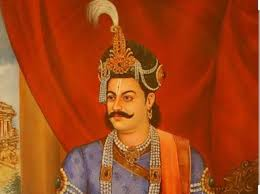Context:
A remarkable discovery was made at the Sri Singeeswarar temple in Mappedu village, Tiruvallur district, with the unearthing of copper plate inscriptions dating back to the 16th century. These inscriptions narrate a village donation by the Raja of Chandragiri to Brahmins. The inscriptions, engraved in the year 1513, during the time of King Krishnadevaraya, are in Sanskrit and the Nandinagari script and thus tell us much about the administrative and cultural practices of the period.
Relevance:
GS I: History
Dimensions of the Article:
- Vijayanagara Empire
- Krishnadevaraya (1509-1529 A.D.)
- About Sri Singeeswarar Temple
Vijayanagara Empire
Foundation and Dynastic Rule
- The Vijayanagara Empire was founded in 1336 by Harihara I (Hakka) and Bukka Raya I in the Deccan region of Southern India.
- Hampi, known for its architectural grandeur and strategic location, served as the capital and was later recognized as a UNESCO World Heritage site in 1986.
- The empire was governed by four major dynasties: Sangama, Saluva, Tuluva, and Aravidu, each contributing to its development and expansion.
Cultural and Economic Flourishing
- The empire reached its cultural and political zenith during the reign of Krishna Deva Raya from the Tuluva Dynasty, expanding its territories and enhancing its architectural landscape.
- Vijayanagara is famed for its monumental temples like the Virupaksha and Vittala temples, which showcase intricate carvings and expansive courtyards, reflecting the empire’s architectural innovation.
- The empire engaged in significant trade with the Portuguese, exchanging spices, cotton, and other goods for military technology like guns and Arabian horses.
Military and Political Dominance
- For over two centuries, the Vijayanagara Empire was a dominant force in Southern India, acting as a bulwark against invasions from the north and maintaining stability in the region.
- The empire was frequently in conflict with the Deccan Sultanates and later the Mughals, often over strategic territories like the Raichur Doab, an area rich in resources.
Relations with the Portuguese
- he Portuguese capture of Goa in 1510 facilitated an alliance with Vijayanagara, bolstering the empire’s military capabilities and enhancing its maritime trade routes.
Decline and Aftermath
- Battle of Talikota: The empire faced a severe setback in 1565 at the Battle of Talikota, where it was decisively defeated by a coalition of Deccan Sultanates, leading to the sacking and abandonment of Hampi.
- Gradual Decline: After the Battle of Talikota, the empire continued in a diminished state until about 1660, with its political and military influence waning significantly.
Legacy
- The legacy of the Vijayanagara Empire is preserved in its ruins at Hampi and its contributions to South Indian architecture, religion, and the arts, which continue to be studied and admired for their historical significance and artistic value.
Krishnadevaraya (1509-1529 A.D.)

- Krishnadevaraya of the Tuluva dynasty was the most famous king of the Vijayanagar Empire
- According to Domingo Paes, a Portuguese traveler “Krishnadevaraya was the most feared and perfect king there could possibly be”.
- He conquered Sivasamudram in 1510 A.D and Raichur in 1512A.D
- In 1523 A.D. he captured Orissa and Warangal
- His empire extended from the river Krishna in the north to River Cauvery in the south; the Arabian Sea in the west to Bay of Bengal in the East.
Krishnadevaraya‘s Contributions
- Krishnadevaraya was an able administrator, and it was during his period the Vijayanagar Empire reached its zenith of glory.
- He built large tanks and canals for irrigation and he also developed the naval power understanding the vital role of overseas trade.
- He maintained friendly relations with the Portuguese and Arab traders.
- He patronized art and architecture and was a great scholar himself.
- He was an eminent scholar and authored works such as Madalasa Charita, Satyavedu Parinaya, Rasamanjari, Jambavati Kalyana, and Amuktamalkyada.
- Fluent in multiple languages, he supported poets writing in Sanskrit, Telugu, Tamil, and Kannada.
- Ashtadiggajas is the collective title given to the eight Telugu scholars and poets in the court of Krishnadevaraya, and they are:
- Allasani Peddanna – the author of Manucharitram, he was also known as Andhra Kavitapitamaha
- Nandi Thimmana – the author of Parijathapaharanam
- Madayagari Mallana
- Dhurjati
- Ayyalaraju Ramabhadra Kavi
- Pingali Surana
- Ramaraja Bhushana
- Tenali Ramakrishna
About Sri Singeeswarar Temple:
- It is a Hindu temple dedicated to Lord Shiva.
- This temple is at Mappedu village near Perambakkam in Thiruvallur District of Tamil Nadu.
- The temple was built by the great Aditya Karikalan II in 976 AD
- He is the father of the great Chola emperor Rajaraja Cholan, who built the Thanjavur Big Temple.
- In the later period, under Krishnadevaraya, his viceroy Dalavai Ariyanadha Mudaliar, exercised influence and built the Rajagopuram-Main Tower, compound wall, and 16-pillar Mandap in the year 1501.
- The Temple is constructed in the style of Dravidian architecture, and the Rajagopuram has 5 tiers.
- The chief deity is called Singeeswarar. Singeeswarar is found in the form of a slightly big Shiva Lingam in the sanctum.
-Source: The Hindu



